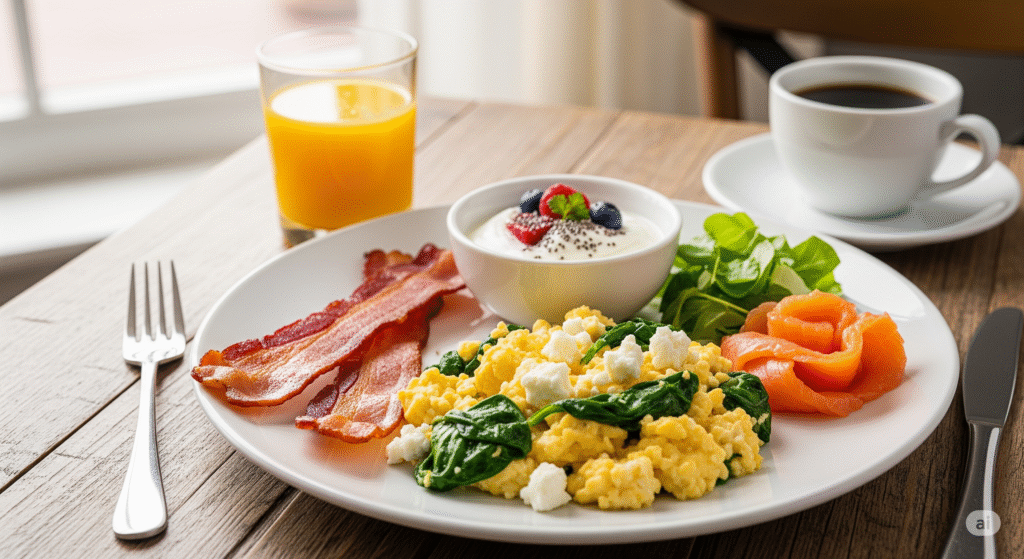SMART Goals for Weight Loss: A Proven Blueprint to Lose Weight Effectively
Losing weight is a goal many of us set. But here’s the problem:
“Lose weight” isn’t a real plan—it’s a hope.
If you want to drop pounds and keep them off, you need a system.
And that’s where SMART goals come in.
In this blog, you’ll learn:
- What SMART goals are
- How to set them for your weight loss journey
- Real-life examples to guide you
- How to stay accountable and track progress
Let’s ditch vague resolutions and build real results—one goal at a time.
🎯 What Are SMART Goals?
SMART is an acronym for goals that are:
- Specific
- Measurable
- Achievable
- Realistic
- Time-bound

This goal-setting method is used by professionals, athletes, and anyone serious about success. It works especially well for weight loss, because it turns big dreams into manageable action steps.
✅ Why Use SMART Goals for Weight Loss?
Because they help you:
- Stay focused
- Track your progress
- Keep yourself motivated
- Avoid burnout and overwhelm
- Build habits that actually stick
When your goals are crystal clear, your actions become powerful.
📝 How to Create SMART Weight Loss Goals
1. Specific
❌ Vague goal: “I want to lose weight.”
✅ SMART goal: “I want to lose 5 kg in the next 60 days by walking daily and eating balanced meals.”
A specific goal answers:
- What exactly do I want to achieve?
- How will I do it?
2. Measurable
You need to track your progress. Otherwise, how will you know if you’re succeeding?
✅ Example:
- “I will walk 8,000 steps per day.”
- “I will reduce sugar intake to 1 dessert per week.”
- “I’ll track meals using a food journal.”
Use:
- A weighing scale
- Tape measure
- Fitness tracker
- Photos
- Journal entries
How to Turn Weight Loss Challenges Into Motivation: 10 Real-Life Strategies
3. Achievable
Don’t set goals so extreme that they set you up to fail.
❌ Unrealistic: “I’ll lose 10 kg in 10 days.”
✅ Achievable: “I’ll lose 1 kg per week with portion control and daily walks.”
Your body needs time to adjust. Aim for slow and steady progress.
4. Realistic
Can you do it with your current schedule, budget, and energy?
✅ Realistic goals:
- “Cook healthy meals 4 days a week”
- “Exercise for 30 minutes, 3 times a week”
- “Sleep at least 7 hours each night”
Sustainable goals build long-term habits.
5. Time-Bound
Set a deadline to stay motivated and create a sense of urgency.
✅ Example:
- “I’ll lose 5 kg in 8 weeks.”
- “I’ll complete 12 workouts this month.”
- “I’ll track meals daily for 21 days.”
SMART Goal Examples for Shedding Pounds
Example 1: Nutrition Goal
SMART Goal:
“I will cook healthy dinners at home 5 nights a week for the next 4 weeks to reduce eating out and stay within my calorie limit.”

Example 2: Exercise Goal
SMART Goal:
“I will do a 30-minute strength training workout 4 times a week for the next 6 weeks using YouTube videos.”
Example 3: Hydration Goal
SMART Goal:
“I will drink 2 liters of water per day for the next 30 days by keeping a bottle with me at all times.”
Example 4: Lifestyle Goal
SMART Goal:
“I will get 7–8 hours of sleep every night for the next 21 days by turning off screens by 10 PM.”
📊 How to Track SMART Goal Progress
Use simple tools like:
- Habit tracker apps (e.g., Habitica, Strides, Loop)
- Fitness apps (e.g., MyFitnessPal, Fitbit, Google Fit)
- Journals or spreadsheets
- Weekly progress photos
🎯 Pro Tip: Review goals every Sunday. Ask:
- What worked?
- What didn’t?
- What will I improve next week?
🔁 What to Do When You Slip Up
It happens to everyone.
The key is to reframe the setback:
- “This isn’t failure. It’s feedback.”
- “I can restart today. Not Monday. Not next week—today.”
✅ Adjust your goal if needed
✅ Don’t aim for perfection—aim for consistency
✅ Celebrate small wins
💪 Build SMART Goals Around These Healthy Habits

| Habit Area | SMART Goal Example |
|---|---|
| Breakfast | Eat a high-protein breakfast 5 days a week for the next month |
| Portion Control | Use the plate method at lunch and dinner for 21 straight days |
| Cardio | Walk briskly for 30 minutes, 5 times a week for 6 weeks |
| Strength Training | Do bodyweight exercises 3x/week for 20 minutes for 30 days |
| Sleep | Sleep by 10:30 PM on weeknights for the next 3 weeks |
📚 Trusted Resources
- CDC – Setting Goals for Weight Loss
- Harvard Health – Healthy Weight Loss
- NHS – 12-Week Weight Loss Plan
❓Frequently Asked Questions (FAQs)
❓Why should I use SMART goals for weight loss?
Because they give structure, clarity, and motivation. SMART goals break big dreams into realistic action steps.
❓What if I don’t meet my goal in time?
That’s okay! Reassess and adjust. Focus on progress, not perfection. Even if you only achieve 70%, that’s better than 0%.
❓How do I stay motivated?
Track your wins, surround yourself with support, and review your “why” often. Mix up your routine to avoid boredom.
❓Can I lose weight without tracking?
You can, but tracking helps with accountability. Even basic logging (e.g., writing what you ate) can reveal powerful insights.
❓How long should I give each goal?
Try short cycles: 2–4 weeks. Review and reset. This keeps the momentum going and makes larger goals feel less overwhelming.
🏁 Final Thoughts: SMART Goals = Smart Results
If you’re tired of starting over, set goals the SMART way.
The more specific, measurable, and realistic your weight loss goals are, the more confident and in control you’ll feel.
So instead of saying “I want to lose weight,” say:
“I will walk 5,000 steps daily, track my meals, and cook 5 times a week for the next 30 days.”
Because the more clear your path, the easier it is to follow.
